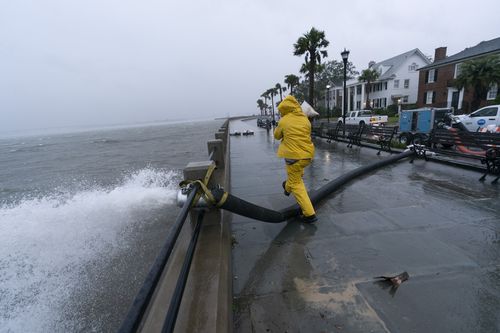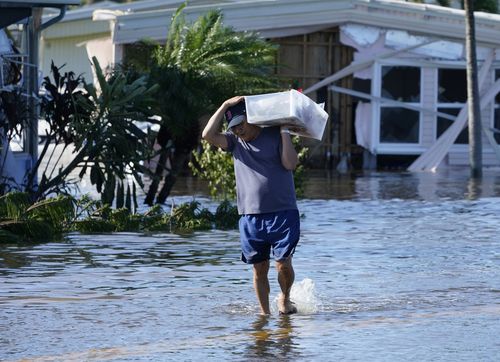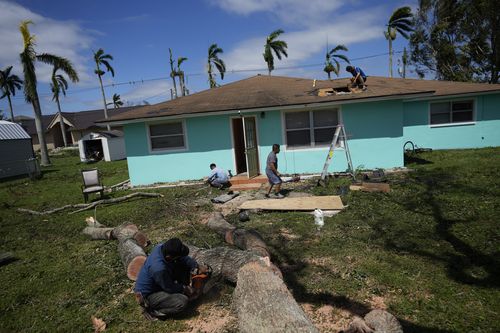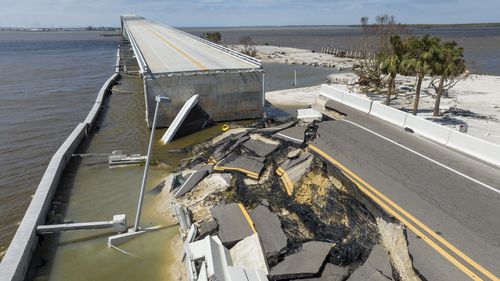Its centre, just dozens of miles from shore, was due to move onto land between Charleston and Myrtle Beach, forecasters said, with high winds already hitting much of the Carolinas’ coast and life-threatening storm surge and damaging winds expected soon.

“This is a dangerous storm that will bring high winds and a lot of water,” South Carolina Gov. Henry McMaster tweeted.
“Be smart, make good decisions, check on your loved ones, and stay safe.”
Sheets of rain whipped trees and power lines, and many areas on Charleston’s downtown peninsula were already under water by midday (2am Saturday AEST). Streets in the 350-year-old city were largely empty.
Ian’s anticipated landfall just up the South Carolina coast was expected to coincide with high tide, which would make flooding worse.
In South Carolina, Charleston International Airport’s airfield closed Friday because of high winds, the airport said. And Myrtle Beach residents are urged to stay inside during the storm, Mayor Brenda Bethune told CNN.
As Ian moved away from Florida, governors in South Carolina, North Carolina, Georgia and Virginia declared emergencies.
In North Carolina, Gov. Roy Cooper urged residents to prepare for torrents of rain, high winds and potential power outages.
The storm likely will have left behind lasting changes to Atlantic landscapes. Coastlines along Georgia and South Carolina may sustain significant alterations because the powerful waves and storm surges brought by Ian could inundate coastal sand dunes, according to the US Geological Survey.

In addition to flooding communities behind the dunes, the storm may push sand back and deposit it inland, which could “reduce the height of protective sand dunes, alter beach profiles and leave areas behind the dunes more vulnerable to future storms,” the agency said.
Florida left with swath of destruction
The storm flooded areas on both of Florida’s coasts, tore homes from their slabs, demolished beachfront businesses and left more than 2 million people without power. At least seven people were confirmed dead in the US — a number that was almost certain to increase as officials confirm more deaths and search for people.
Rescue crews piloted boats and waded through riverine streets Thursday to save thousands of people trapped amid flooded homes and buildings shattered by the hurricane.

Florida Gov. Ron DeSantis said Friday that rescue crews had gone door-to-door to over 3,000 homes in the hardest-hit areas.
“There’s really been a Herculean effort,” he said during a news conference in Tallahassee.
And now, the storm’s aftermath poses new, deadly dangers of its own. Some standing water is electrified, officials warned, while maneuvering through debris-strewn buildings and streets – many without working traffic signals – risks injury. Lack of air conditioning can lead to heat illness, and improper generator use can cause carbon monoxide poisoning.
Those killed in Florida included a 67-year-old man who was waiting to be rescued and fell into rising water inside his New Smyrna Beach home late Thursday, the Volusia County Sheriff’s Office said. Patrol vehicles had been unable to reach him because roads were flooded.
At least three people were reported killed in Cuba after the hurricane struck there on Tuesday.
In the Fort Myers area, businesses near the beach were completely razed, leaving twisted debris. Broken docks floated at odd angles beside damaged boats. Fires smoldered on lots where houses once stood.

“I don’t know how anyone could have survived in there,” William Goodison said amid the wreckage of a mobile home park in Fort Myers Beach where he’d lived for 11 years. Goodison said he was alive only because he rode out the storm at his son’s house inland.
The hurricane tore through the park of about 60 homes, leaving many destroyed or mangled beyond repair, including Goodison’s single-wide home. Wading through waist-deep water, Goodison and his son wheeled two trash cans containing what little he could salvage — a portable air conditioner, some tools and a baseball bat.
The road into Fort Myers was littered with broken trees, boat trailers and other debris. Cars were abandoned in the road, having stalled when the storm surge flooded their engines.

Emergency crews sawed through toppled trees to reach stranded people. Many in the hardest-hit areas were unable to call for help because of electrical and cellular outages.
A helicopter flight over Fort Myers Beach shows utter devastation: empty or debris-littered lots where homes and businesses used to be and boats tossed into mangroves.
“You’re talking about no structure left. … You’re talking about homes that were thrown into the bay. This is a long-term fix, and it’s life-changing,” Lee County Sheriff Carmine Marceno said.
A chunk of the Sanibel Causeway fell into the sea, cutting off access to the barrier island where 6,300 people live.

Record flooding was recorded across central and northern Florida, including at least three rivers that hit all-time flood records
Hours after weakening to a tropical storm while crossing the Florida peninsula, Ian regained strength Thursday evening over the Atlantic.
The National Hurricane Center predicted it would hit South Carolina as a Category 1 hurricane Friday, still much weaker than the Category 4 hurricane it was on Wednesday.
National Guard troops were being positioned in South Carolina to help with the aftermath, including any water rescues. And in Washington, President Joe Biden approved an emergency declaration for the state, a needed step to speed federal assist for recovery once Ian passes.









